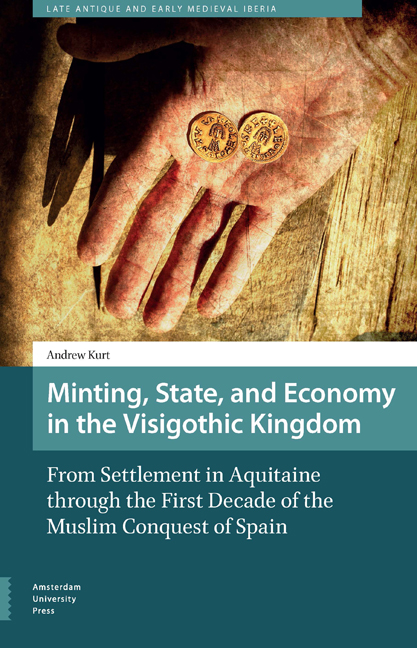 Minting, State, and Economy in the Visigothic Kingdom
Minting, State, and Economy in the Visigothic Kingdom Book contents
- Frontmatter
- Contents
- List of figures
- Acknowledgments
- Introduction
- 1 Pre-Regal Visigothic Coinage
- 2 The King’s Coinage: The Beginning and Development of theRegal Coinage (c. 573-c. 720) 81 A The Transition to a Regal
- 3 The Activities of the Mints from c. 573- c. 720
- 4 Why Were Gold Coins Struck in the Visigothic Kingdom?
- 5 The Royal Control of Visigothic Minting
- 6 Coinage in Spain in the Aftermath of the Islamic Conquest
- 7 Visigothic Currency in the Early Medieval Economy
- Conclusion
- Appendix I
- Appendix II
- Bibliography
- About the Author
- Index
4 - Why Were Gold Coins Struck in the Visigothic Kingdom?
Published online by Cambridge University Press: 21 November 2020
- Frontmatter
- Contents
- List of figures
- Acknowledgments
- Introduction
- 1 Pre-Regal Visigothic Coinage
- 2 The King’s Coinage: The Beginning and Development of theRegal Coinage (c. 573-c. 720) 81 A The Transition to a Regal
- 3 The Activities of the Mints from c. 573- c. 720
- 4 Why Were Gold Coins Struck in the Visigothic Kingdom?
- 5 The Royal Control of Visigothic Minting
- 6 Coinage in Spain in the Aftermath of the Islamic Conquest
- 7 Visigothic Currency in the Early Medieval Economy
- Conclusion
- Appendix I
- Appendix II
- Bibliography
- About the Author
- Index
Summary
Abstract
From descriptions of tremisses, mints, and their operations, Chapter Four aims to explain why the Visigothic state minted gold currency. A smaller category of primary mints played a key role in fiscal operations: the major cities were the destinations for tax revenues and took the lead in minting. Secondary mints, widely dispersed, were a much larger category. Military connections emerge as the single obvious factor in the placement of these temporary mints. These connections explain how a seemingly odd geographical distribution was deemed convenient and could result in exceptionally high output. Southern Iberian mints, late on in the war against Byzantine occupation, are only the most obvious case here. Under Leovigild, propagandistic legends were also incorporated into numerous emissions.
Keywords: purpose; primary mints; secondary mints; taxation; fiscal; military
The Late Roman Context
The previous chapters have described the Visigothic minting system in Gaul and Spain as well as it can now be known and have offered evidence of the manner in which minting was carried out at the many sites. Equipped with extensive data on the minting network and operations – the ‘what and how,’ so to speak, of monetary production in the Visigothic kingdom – the much broader question of why the coins were made can be addressed. This second field of inquiry is every bit as important as the first. Without contemporary documents to inform us about the matter, the question of why minting was undertaken is unfortunately impossible to answer with the relative precision which one can attain about the facts of coined money now above ground. The coins yield much information about what the workshops were doing, but tell nothing directly about the reason for their being struck. The answer is in the realm of conjecture, yet with more numismatic data now in hand we are in a position to judge which hypotheses concerning the purpose of minting are most tenable.
Some of the earliest authors to take up the matter concluded from the legends of Visigothic solidi and tremisses, and from occasional holes in the coins or attached loops, that the gold pieces served primarily as political monuments and as decorative pendants.
- Type
- Chapter
- Information
- Minting, State, and Economy in the Visigothic KingdomFrom Settlement in Aquitaine through the First Decade of the Muslim Conquest of Spain, pp. 173 - 230Publisher: Amsterdam University PressPrint publication year: 2020


